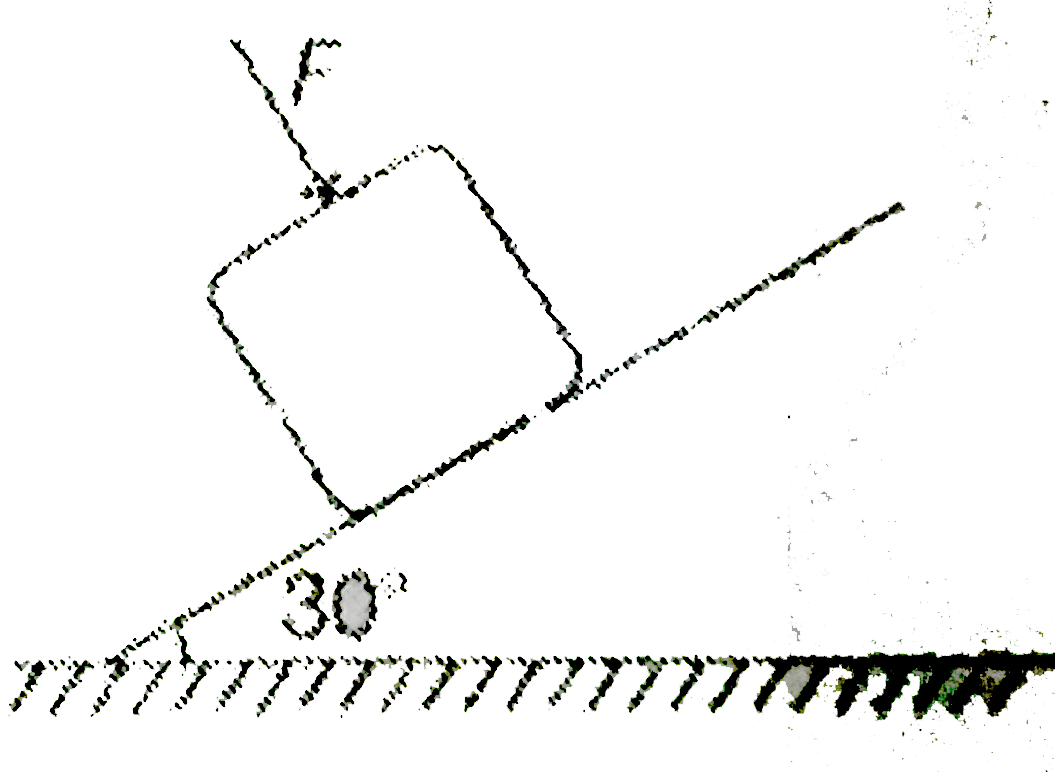A block of weight 1 N rests on a inclined plane of inclination with the horizontal. The coefficient of friction between the block and the inclined plane is . The minimum force that has to be applied parallel to the inclined plane to make the body just move up the plane is
To solve the problem, we need to determine the minimum force Fmin that must be applied parallel to the inclined plane to make the block move upwards. Here’s a step-by-step breakdown of the solution:
Step 1: Identify the forces acting on the block
The block experiences the following forces:
- Weight of the block W=mg=1N acting vertically downwards.
- Normal force N acting perpendicular to the inclined plane.
- Frictional force f acting down the incline (opposing the motion).
- Applied force Fmin acting up the incline.
Step 2: Resolve the weight into components
The weight W can be resolved into two components:
- Perpendicular to the incline: W⊥=mgcosθ
- Parallel to the incline: W∥=mgsinθ
Step 3: Write the equation of motion
When the block is just about to move up the incline, the net force acting on it is zero. Therefore, we can write the equation:
Fmin−f−W∥=0
Where f is the frictional force.
Step 4: Determine the frictional force
The frictional force can be expressed as:
f=μN
Since the block is not moving vertically, the normal force N is equal to the perpendicular component of the weight:
N=mgcosθ
Thus, the frictional force becomes:
f=μ(mgcosθ)
Step 5: Substitute the values into the equation
Substituting the expressions for f and W∥ into the equation gives:
Fmin−μ(mgcosθ)−(mgsinθ)=0
Step 6: Solve for Fmin
Rearranging the equation to solve for Fmin:
Fmin=μ(mgcosθ)+(mgsinθ)
Step 7: Substitute mg=1N
Since mg=1N:
Fmin=μ(1⋅cosθ)+(1⋅sinθ)
Thus:
Fmin=μcosθ+sinθ
Final Answer
The minimum force that has to be applied parallel to the inclined plane to make the body just move up the plane is:
Fmin=μcosθ+sinθ
The block experiences the following forces:
- Weight of the block W=mg=1N acting vertically downwards.
- Normal force N acting perpendicular to the inclined plane.
- Frictional force f acting down the incline (opposing the motion).
- Applied force Fmin acting up the incline.
The weight W can be resolved into two components:
- Perpendicular to the incline: W⊥=mgcosθ
- Parallel to the incline: W∥=mgsinθ
When the block is just about to move up the incline, the net force acting on it is zero. Therefore, we can write the equation:
Fmin−f−W∥=0
Where f is the frictional force.
The frictional force can be expressed as:
f=μN
Since the block is not moving vertically, the normal force N is equal to the perpendicular component of the weight:
N=mgcosθ
Thus, the frictional force becomes:
f=μ(mgcosθ)
Substituting the expressions for f and W∥ into the equation gives:
Fmin−μ(mgcosθ)−(mgsinθ)=0
Rearranging the equation to solve for Fmin:
Fmin=μ(mgcosθ)+(mgsinθ)
Since mg=1N:
Fmin=μ(1⋅cosθ)+(1⋅sinθ)
Thus:
Fmin=μcosθ+sinθ
The minimum force that has to be applied parallel to the inclined plane to make the body just move up the plane is:
Fmin=μcosθ+sinθ
Topper's Solved these Questions
- LAWS OF MOTIONBook:AAKASH INSTITUTE ENGLISHChapter:LAWS OF MOTIONExercise:Assignment (SECTION-C)
Explore 63 Videos
- LAWS OF MOTIONBook:AAKASH INSTITUTE ENGLISHChapter:LAWS OF MOTIONExercise:Assignment (SECTION-D) (Assertion-Reason Type Questions)
Explore 15 Videos
- LAWS OF MOTIONBook:AAKASH INSTITUTE ENGLISHChapter:LAWS OF MOTIONExercise:Assignment (SECTION-A)
Explore 65 Videos
- KINETIC THEORYBook:AAKASH INSTITUTE ENGLISHChapter:KINETIC THEORYExercise:EXERCISE (ASSIGNMENT) SECTION - D Assertion - Reason Type Questions
Explore 10 Videos
- MAGNETISM AND MATTER Book:AAKASH INSTITUTE ENGLISHChapter:MAGNETISM AND MATTER Exercise:ASSIGNMENT (SECTION D)
Explore 26 Videos
Similar Questions
A block of mass m slides down an inclined plane of inclination θ with uniform speed. The coefficient of friction between the block and the plane is μ. The contact force between the block and the plane is
View SolutionA block of mass m slides down an inclined plane which makes an angle θ with the horizontal. The coefficient of friction between the block and the plane is μ. The force exerted by the block on the plane is
View Solution
Knowledge Check
A block of mass 2kg rests on a rough inclined plane making an angle of 30∘ with the horizontal. The coefficient of static friction between the block and the plane is 0.7. The frictional force on the block is
A10.3NB23.8NC11.9ND6.3NA block of mass 3 kg rests on a rough inclined plane making an angle of 30∘. With the horizontal. The coefficient of static friction between the block and the plane is 0.7. The frictional force on the block is
A9.8 NB0.7×9.8×√3 NC9.8×√3 ND0.7×9.8 NA block of mass m=2kg is resting on a rough inclined plane of inclination of 30∘ as shown in figure. The coefficient of friction between the block and the plane is μ=0.5. What minimum force F should be applied perpendicular to the plane on the block, so that blocks does not slip on the plane? (g=10m/s2)
 A2.68 NBZeroC4.34 ND6.24 N
A2.68 NBZeroC4.34 ND6.24 N
A block of mass 2kg rests on a rough inclined plane making an angle of 30∘ with the horizontal. The coefficient of static friction between the block and the plane is 0.7. The frictional force on the block is
View SolutionA block of mass m is at rest on a rough inclined plane of angle of inclination θ. If coefficient of friction between the block and the inclined plane is μ, then the minimum value of force along the plane required to move the block on the plane is
View SolutionA block of mass m is placed on a smooth inclined plane of inclination θ with the horizontal. The force exerted by the plane on the block has a magnitude
View SolutionA block of mass m is placed on a smooth inclined plane of inclination θ with the horizontal. The force exerted by the plane on the block has a magnitude
View SolutionA block of mass m is placed at rest on an inclination θ to the horizontal. If the coefficient of friction between the block and the plane is μ, then the total force the inclined plane exerts on the block is
View Solution